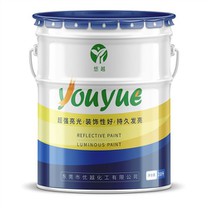In the urban transportation system, tunnels serve as links connecting cities and are divided into urban tunnels (such as river-crossing tunnels, urban culvert tunnels) and highway tunnels. There are huge differences in traffic volume and speed among these tunnels. Therefore, when choosing reflective paint for tunnels, it is necessary to comprehensively consider urban characteristics, the performance of reflective paint, and regional climate differences to ensure that the selected reflective paint is both safe, practical, and economical. sex.
City tunnel vs. highway tunnel
Urban tunnels are usually located in urban areas, where the traffic flow is relatively dense, but the vehicle speed is low. At the same time, urban tunnels generally have lighting systems. Correspondingly, highway tunnels carry higher speeds and larger traffic volumes, and most tunnels do not have lighting systems. For these two types of tunnels, the choice of reflective paint needs to be tailored to local conditions.
Reflective paint selection for urban tunnels
In urban tunnels, there are no special requirements for the reversal coefficient of reflective paint. In fact, it is in line with actual usage conditions. Since active lighting equipment has been laid in urban tunnels, drivers can clearly distinguish driving trajectories and ensure driving safety.
Why must urban tunnels be painted with reflective paint?
You may ask, since active lighting systems are sufficient, why do we still need to use reflective paint?
The word "redundancy" or "backup" is mentioned here. Reflective paint is the redundancy of the active lighting system. When the active lighting system can work normally, the reflective paint looks like redundancy. Once the active lighting system fails, such as maintenance, malfunction, etc., the reflective paint is a backup. Even if the active lighting system fails, the reflective paint can still ensure the driver's normal form under the illumination of the car lights, and the entire traffic will not be paralyzed.
Take the river-crossing tunnel as an example. Due to the low speed limit, the normal driving speed is generally 60 yards. Even without an active lighting system, the route is completely indicated by reflective paint. It is completely sufficient to choose a retroreflection coefficient of about 100. On the contrary, the cost of choosing reflective paint specifically for highways is extremely uneconomical. In urban construction, it is necessary to have sufficient functions while reducing investment costs and maximizing cost performance.
Reflective paint selection for highway tunnels
In comparison, highway tunnels require reflective paint with a higher retroreflection coefficient. Reflective paint specifically used on highways, such as yellow with a retroreflection coefficient of 350 and white with a retroreflection coefficient of 400, ensures that road markings are clearly visible among high-speed vehicles and increases the safety of driving at night.
There is no need to explain too much here. The speed of highways is often 100-120 yards, and highways do not have lighting systems. They completely rely on the lighting of car lights. The requirements for the reflection coefficient of reflective paint are particularly high, and the reflected light must be sufficient. Only when the distance is more than 200 meters can the driver see clearly, giving the driver enough time to make a prediction.
How to correctly choose reflective paint for tunnels has been summarized here for everyone. You can choose according to the following principles.
Retroreflection coefficient requirements and selection
Retroreflection coefficient requirements vary depending on tunnel type. Urban tunnels can moderately reduce retroreflection coefficients, while highway tunnels need to focus on high retroreflection coefficients. The correct selection of retroreflection coefficient is an important step to ensure the safety of driving at night.
Cost-effectiveness considerations and choices
On the premise of achieving safety, the consideration of cost performance is particularly important. The price of special reflective paint for highways is relatively high, while the paint for urban tunnels is relatively economical. The choice of reflective paint with good performance and economical practicality is the basis for maintaining the long-term viability of tunnel facilities.
The impact of regional climate differences on reflective paint
Climatic conditions in different regions have a significant impact on the performance of reflective paint, so the climate differences between the north and the south need to be considered when choosing.
Choice for humid areas in the south
In humid areas in the south, it is more appropriate to choose quick-drying reflective paint. This kind of paint has a shorter drying time, can better adapt to humid climates, and improves construction efficiency.
Choice for northern dry areas
Relatively speaking, the climate in the north is relatively dry and there are no special requirements for paint. In this case, you can choose a more versatile reflective paint, focusing on its retroreflective coefficient and weather resistance.
Conclusion
In the selection process of tunnel reflective paint, we need to fully consider the different characteristics of urban tunnels and highway tunnels, and formulate a reasonable selection strategy based on the performance requirements of reflective paint and regional climate differences. The correct choice can not only improve the driver's driving safety, but also strike a balance between economic and practicality. Therefore, the selection of tunnel reflective paint needs to be considered more comprehensively to ensure the smoothness and safety of the urban transportation system.





